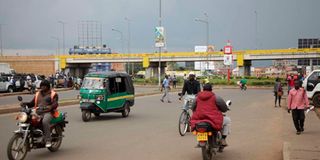Why Kenya didn’t blow up over the election

Residents go about their business as usual at the Kondele roundabout in Kisumu following the Supreme Court ruling on the presidential election petition on September 5, 2022.
Ahead of Monday’s Supreme Court ruling on the petition brought by former Prime Minister Raila Odinga against the declaration of Deputy President William Ruto as the winner of the August 9 presidential election, the United States embassy in Nairobi issued an advisory to American nationals to stay away from Kisumu.
Kisumu is Odinga’s home region. The embassy feared violence would erupt if the Supreme Court, as it did, struck down Odinga’s petition. TVs showed some upset Kisumu residents but there was no violence. Even the burning of tyres, the symbol of Kenyan street political discontent, wasn’t there this time round.
In 2013, when outgoing President Uhuru Kenyatta won the election with Ruto as his running mate, nearly all foreign journalists who came to Kenya to cover the elections or were based in Nairobi congregated in the Rift Valley. They were expecting a flare-up like the one that left 1,500 people dead and more than 600,000 displaced following the disputed December 2007 vote.
Empty-handed
They came back empty-handed. Blood didn’t flow. Tyres were lit in Kisumu and a few other places then but, by morning, the embers were out. All this, even though anger over election outcomes, fuelled to higher levels in these times by social media, seems to have increased.
One reason for this, as many observers and scholars have noted, is a result of devolution. Possibly up to 50 per cent of the political passions during general elections could be consumed by local county politics—over who will be governor. The designers of the 2010 Constitution probably didn’t think of devolution as an antidote to violent fury over the outcome of presidential elections, but it turned out to be.
One enduring image from 2013 was a TV interview of Odinga supporters in Kisumu after Kenyatta was declared the winner. They raged at their man’s loss and allegations that he had been robbed at the ballot. Tears streamed down their faces. In the end, they shrugged their shoulders and said they would return to their lives and leave matters in God’s hands.
However, anybody who had been to Kisumu in 2007 and seen how it had transformed by 2013 (not to mention the nearly shining city on the Victoria lakeside that it is today) wouldn’t be surprised they didn’t lash out in their disappointment.
MCA position
This year, there was another development. We saw what one could describe as a boost to the miniaturisation of political emotion. The most profound development in the latest electoral cycle is what happened to the humble position of Member of the County Assembly (MCA). The competition for MCA was more spirited than most MP and senatorial seats. There was a massacre there, with nearly all of the 1,450 incumbent MCAs being swept out. In several counties, none retained their seat.
However, the most surprising thing there was the jump in the calibre of candidates. In 2013, there was a view that the MCA was a “village” “upcountry thing”. Not anymore. Several MCAs were worthy as presidential, MP and senatorial candidates. If you take 2013 as your base, the jump in quality of candidates for the position was higher than there has ever been for president, MP or senator. It was like Tiger Woods entering to play in the Nyeri Golf Tournament. The Nyeri Golf Tournament would become more significant than the Nyeri Golf Tournament right there and then. The county assemblies, in the process, became a bigger soak pit for the angst over presidential election outcomes than they have ever been.
Political determinism
The other reason is not necessarily laudatory. Kenya seems to have entered a stage of geographical political determinism and its accompanying fatalism that we see in countries like Ethiopia. Since Independence, the country has only had presidents from the highlands in the Rift Valley and central Kenya.
More than ethnicity, altitude and the hardy politics bred by the highlands have so far seemed to determine who gets to be president. The lower your region and place of your birth, the less your chances of becoming the President in Nairobi. Outside a small motivated political class, most people of the Kenyan lowlands seem to have embraced fatalism and turned their back on the national project.
Extremely unhappy
Elsewhere, I wrote about an expatriate in Nairobi who got deeply wrapped in the presidential poll and was on Odinga’s side. When the IEBC called the election for Ruto, she was extremely unhappy and called up her Kenyan friend, whom she thought was a dyed-in-the-wool Odinga supporter.
It wasn’t clear whether or not he had voted. But she was surprised that he didn’t share in her outrage, even asking her what was “killing her”. He had a Netflix movie to finish. A fellow from the lowlands, he told her his surprise was not that Odinga hadn’t won. Rather, he would have been blown out of his skin if he had. He had no beef with IEBC chief Wafula Chebukati.
He said that Kenya structurally was a country where an Odinga (and presumably other lowlanders) would never become president at the ballot. Hopefully, time will prove him wrong.
Mr Onyango-Obbo is a journalist, writer and curator of the "Wall of Great Africans". @cobbo3





